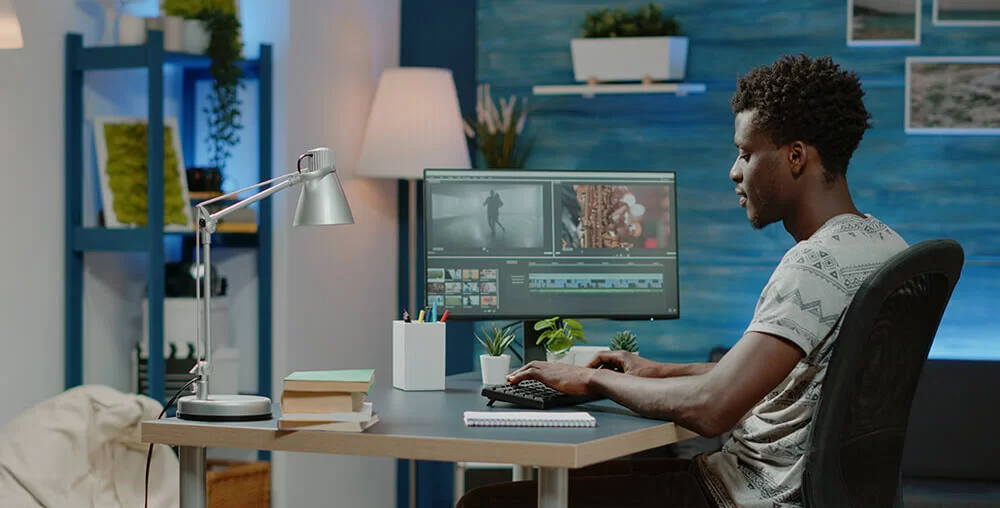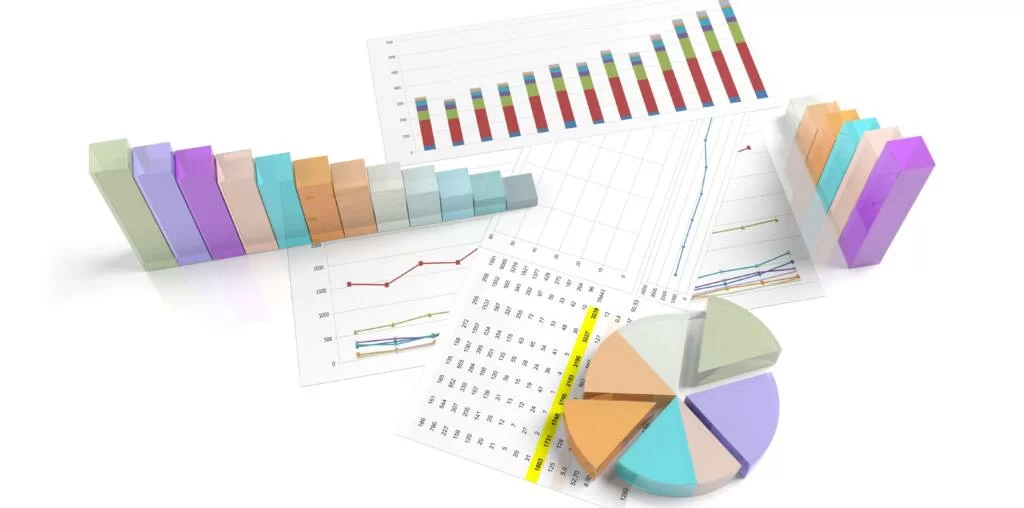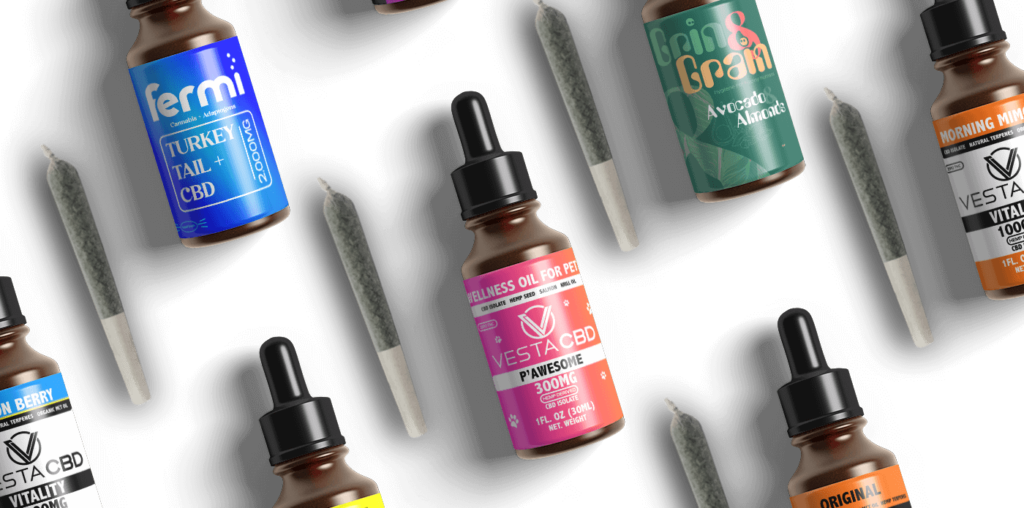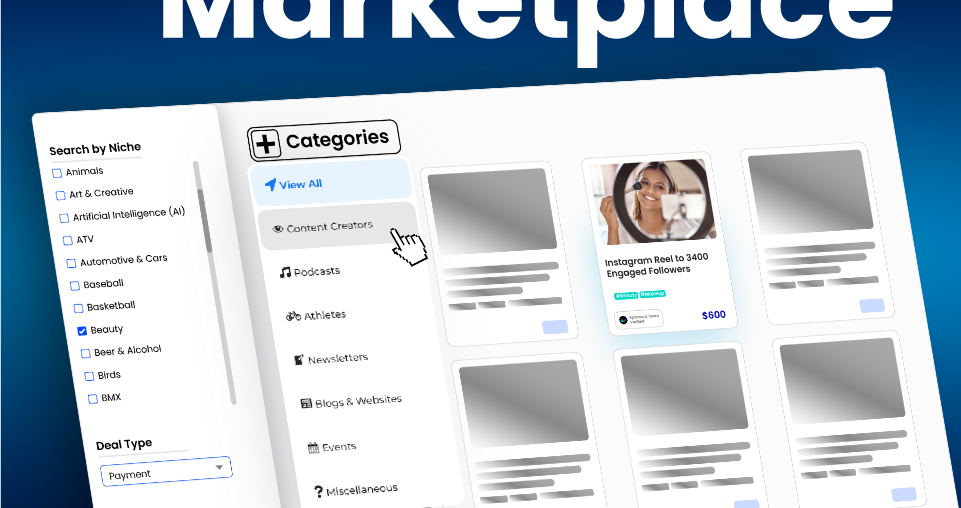YouTube has become a popular platform for creators to showcase their skills and build an audience. However, creating high-quality content consistently takes time, effort, and money. This is where sponsorships come in. Sponsorships provide an opportunity for creators to earn money while doing what they love. So how do YouTubers get sponsors? There are several ways to get sponsorships, including reaching out to brands directly, using talent agencies, and utilizing sponsorship marketplaces like Sponsora. In this post, we will delve into each of these methods and explore how creators can use Sponsora to find brand sponsors. Reaching out to Brands Directly One way that YouTubers can get sponsors is by reaching out to brands directly. This method involves researching brands that align with the creator’s content and audience and then pitching a sponsorship proposal. The proposal should include information about the creator’s audience, the type of content they create, and how the brand can benefit from partnering with them. While this method can be effective, it requires a lot of time and effort. Creators need to identify brands that are a good fit, research their contact information, and craft a persuasive proposal. Additionally, not all brands may be open to sponsorships, and even if they are, they may not have the budget to work with creators. Using Talent Agencies Another way that YouTubers can get sponsors is by working with talent agencies. These agencies specialize in connecting creators with brands and negotiating sponsorship deals on their behalf. They can help creators secure high-paying sponsorships and ensure that the terms of the deal are favorable. However, working with talent agencies comes with a significant drawback: the high fees. Most talent agencies charge a commission of 20-30% of the total sponsorship fee, which can significantly eat into a creator’s earnings. Utilizing a Sponsorship Marketplace like Sponsora The third way that YouTubers can get sponsors is by using sponsorship marketplaces like Sponsora. These platforms connect creators with brands that are looking for sponsorships. Creators can browse through the available sponsorship opportunities and apply to the ones that align with their content and audience. Sponsora, in particular, is a great platform for creators looking to find brand sponsors. The platform features a wide range of niches and talents, making it easy for creators to find opportunities that match their content. Additionally, Sponsora ensures that all creators on the platform are fully opted-in, eliminating the risk of working with scraped data. Moreover, Sponsora offers a flexible fee structure. Creators can choose between a free tier that charges a 15% commission on sponsorship fees or paid plans with lower commission rates. This means that creators can earn more money from sponsorships than they would if they were working with a talent agency. In addition to using Sponsora’s Sponsorship Marketplace, there are several other ways that YouTubers can get sponsorships and brand deals. Networking: YouTubers can reach out to brands directly or attend industry events to network with brand representatives. They can also collaborate with other YouTubers who already have sponsorships and ask for introductions or referrals. Pitching: YouTubers can create a pitch deck that outlines their audience demographics, engagement rates, and content style, and send it to brands they would like to work with. This can be a great way to show brands the value of collaborating with a particular YouTuber. Affiliate programs: Many brands have affiliate programs where YouTubers can earn commissions by promoting their products and services. These programs usually provide YouTubers with a unique referral link to share with their audience. When someone clicks on the link and makes a purchase, the YouTuber earns a percentage of the sale. Product reviews: YouTubers can review products and services on their channels and receive compensation from the brands they feature. This is a common type of sponsorship for beauty, tech, and lifestyle channels. Brands may provide the product for free or pay the YouTuber for their time and review. Sponsored content: YouTubers can create sponsored content for brands that align with their channel’s niche and audience. This can take the form of a dedicated video, sponsored mentions within a video, or branded integrations. Brands may pay a flat fee for the sponsored content or offer a revenue share based on the performance of the video. Overall, there are many different approaches that YouTubers can take to secure sponsorships and brand deals. It’s important to focus on building a strong and engaged audience, creating high-quality content, and building relationships with brands that align with their values and niche. While using a sponsorship marketplace like Sponsora can be an efficient and effective way for YouTubers to find brand sponsors, it’s important to also explore other options and strategies to maximize their earning potential and build long-term partnerships with brands.
Content creation has become a rapidly evolving field, with new technologies constantly reshaping the landscape. One of the most exciting and promising developments in recent years has been the rise of Artificial Intelligence (AI) and its potential impact on content creation. AI has the ability to automate and augment various aspects of content creation, from generating ideas to creating and optimizing content, and even analyzing performance data. In this long-form post, we will explore how content creators can leverage the use of AI for content creation, discussing the potential benefits, challenges, and best practices for incorporating AI into content creation workflows. What is AI and How Does it Work? Artificial Intelligence refers to the ability of a machine or computer program to imitate intelligent human behavior, such as learning, problem-solving, decision-making, and language processing. AI systems can analyze and process large amounts of data, identify patterns and trends, and make predictions or generate content based on the analyzed data. There are various approaches to AI, including machine learning, natural language processing, and computer vision. Machine learning is a subset of AI that involves the use of algorithms and statistical models to enable machines to learn from and make predictions or decisions based on data. Natural language processing (NLP) is a branch of AI that focuses on enabling machines to understand, interpret, and respond to human language. Computer vision is a field of AI that enables machines to interpret visual information from the world, such as images or videos. AI in Content Creation: Potential Benefits The use of AI in content creation offers several potential benefits for content creators, including increased efficiency, enhanced creativity, and improved performance. Here are some ways in which content creators can leverage the use of AI for content creation: Idea Generation: AI can help content creators generate ideas for content by analyzing data, identifying trends, and providing insights on popular topics or keywords. For example, AI-powered tools can analyze social media trends, search engine queries, and user behavior to identify content ideas that are likely to resonate with the target audience. Content Creation: AI can assist in creating content by automating tasks such as content generation, content curation, and content optimization. For instance, AI-powered tools can automatically generate written content, create visual assets, and even edit videos based on predefined templates or algorithms. This can help content creators save time and effort in creating content, especially for repetitive or time-consuming tasks. Personalization: AI can enable content creators to deliver personalized content to their audience based on their preferences, behavior, or demographics. For example, AI-powered recommendation engines can analyze user data and provide personalized content recommendations, improving user engagement and retention. Content Optimization: AI can analyze performance data and provide insights on how to optimize content for better results. For example, AI-powered analytics tools can analyze data on user engagement, conversion rates, and other performance metrics to provide recommendations on how to improve content performance and achieve better outcomes. Automation of Social Media Management: AI can automate social media management tasks, such as scheduling posts, optimizing posting times, and analyzing social media performance data. AI-powered social media management tools can help content creators save time and resources in managing their social media presence, while also improving their social media strategy based on data-driven insights. Improved User Experience: AI can enhance the overall user experience by enabling content creators to create more engaging and interactive content. For example, AI-powered chatbots or virtual assistants can provide personalized recommendations, answer user queries, and offer interactive experiences, enhancing user engagement and satisfaction. Enhanced Creativity: AI can spark creativity by providing content creators with new ideas, insights, and perspectives. For example, AI-powered tools can analyze data from different sources and generate creative suggestions for content topics, formats, or styles. This can inspire content creators to think outside the box and come up with unique and innovative content ideas that may not have been possible without the use of AI. Challenges of Using AI in Content Creation While the use of AI in content creation offers many benefits, there are also challenges and ethical considerations that content creators need to be aware of. Here are some challenges of using AI in content creation: Quality Control: While AI can automate content creation tasks, it may not always produce content of the same quality as human-created content. Content creators need to ensure that the AI-generated content meets their quality standards and aligns with their brand voice and tone. Ethical Considerations: Content creators need to be mindful of the ethical implications of using AI in content creation. For example, AI-generated content may raise concerns about plagiarism, copyright infringement, and the originality of the content. Content creators need to be transparent with their audience about the use of AI in their content and ensure that it complies with relevant laws and regulations. Bias and Fairness: AI systems can perpetuate bias and discrimination if not properly designed and trained. Content creators need to be aware of the potential biases in AI-generated content and take steps to minimize them. This includes carefully selecting and training AI models, validating the output for fairness, and ensuring that the content represents diverse perspectives and voices. Human Touch: Content creation is an art that requires human creativity, emotions, and experiences. While AI can automate certain tasks, it cannot fully replace the human touch in content creation. Content creators need to strike a balance between leveraging AI for efficiency and maintaining their unique creative perspective in their content. Data Privacy and Security: The use of AI in content creation involves the collection and analysis of large amounts of data. Content creators need to ensure that the data used for AI-generated content is collected and stored securely and in compliance with relevant data privacy regulations. They also need to be transparent with their audience about the data collection practices and ensure that their content protects user privacy. Best Practices for Using AI in Content Creation To effectively leverage the use of AI in content
Content creation has become a popular and lucrative career path for many aspiring entrepreneurs, influencers, and creators. With the rise of social media platforms and the increasing demand for digital content, there are numerous niches that offer unique opportunities for content creators to thrive. In this post, we will explore the top 5-10 content creation niches, along with information on the highest paying content on youtube based on CPC (cost per click) from YouTube ads. Personal Finance and Investing With the growing interest in financial literacy and investing, personal finance and investing have become a popular content creation niche. Creators in this niche share tips and advice on budgeting, saving, investing, and building wealth. Content can range from educational videos on investment strategies, reviews of financial products, and interviews with financial experts. The CPC for YouTube ads in this niche can be high, ranging from $0.50 to $2.00 or even higher, depending on the target audience and keywords. Technology and Gadgets As technology continues to advance rapidly, the demand for content related to gadgets, tech reviews, and tutorials has also increased. Creators in this niche cover topics such as smartphone reviews, software tutorials, gaming, and emerging technologies. The CPC for YouTube ads in the technology and gadgets niche can vary, but it generally falls in the range of $0.30 to $1.50 or higher, depending on the competition and target audience. Beauty and Fashion The beauty and fashion niche has been a popular content creation niche for years, with creators sharing beauty tips, makeup tutorials, fashion hauls, and style advice. This niche often attracts a large and engaged audience, making it an attractive choice for content creators. The CPC for YouTube ads in the beauty and fashion niche can range from $0.20 to $1.50 or higher, depending on the target audience and keywords. Travel and Adventure Travel and adventure content has become increasingly popular, with creators sharing their experiences, travel tips, and destination reviews. This niche appeals to those who are passionate about exploring new places and seeking unique adventures. The CPC for YouTube ads in the travel and adventure niche can vary widely, depending on the location, keywords, and target audience, but it can range from $0.30 to $2.00 or higher. Health and Fitness The health and fitness niche is another popular content creation niche, with creators sharing workout routines, nutrition tips, and wellness advice. With the increasing interest in fitness and wellness, this niche offers opportunities for creators to share their knowledge and expertise. The CPC for YouTube ads in the health and fitness niche can vary, but it generally falls in the range of $0.30 to $1.50 or higher, depending on the target audience and keywords. Cooking and Food The cooking and food niche has gained popularity in recent years, with creators sharing recipes, cooking tutorials, and food-related content. This niche attracts food enthusiasts and those who enjoy trying new recipes and exploring different cuisines. The CPC for YouTube ads in the cooking and food niche can range from $0.20 to $1.50 or higher, depending on the target audience and keywords. Parenting and Family The parenting and family niche is a popular choice for content creators who share advice, tips, and stories related to parenting, pregnancy, and family life. This niche appeals to parents, caregivers, and those interested in family dynamics and child development. The CPC for YouTube ads in the parenting and family niche can vary, but it generally falls in the range of $0.20 to $1.00 or higher, depending on the target audience and keywords. Home Improvement and DIY As more people are spending time at home and looking for ways to improve their living spaces, the home improvement and DIY niche has gained popularity. Home improvement is one of the only sectors that sees spikes of growth during economic downturns. Creators in this niche share tutorials, tips, and hacks for home improvement projects, interior design, and DIY crafts. The CPC for YouTube ads in the home improvement and DIY niche can vary, but it generally falls in the range of $0.20 to $1.00 or higher, depending on the target audience and keywords. Lifestyle and Vlogging The lifestyle and vlogging niche is a broad category that encompasses a wide range of topics, such as daily vlogs, challenges, lifestyle hacks, and personal stories. Creators in this niche share their daily lives, experiences, and insights with their audience, creating a sense of connection and relatability. The CPC for YouTube ads in the lifestyle and vlogging niche can vary widely depending on the content and target audience, ranging from $0.10 to $1.00 or higher. Business and Entrepreneurship The business and entrepreneurship niche is gaining popularity as more people are interested in starting their own businesses and pursuing entrepreneurship. Creators in this niche share tips, strategies, and advice on various aspects of business, such as marketing, sales, finance, and leadership. The CPC for YouTube ads in the business and entrepreneurship niche can vary, but it generally falls in the range of $0.50 to $2.00 or higher, depending on the target audience and keywords. It’s important to note that the CPC for YouTube ads can fluctuate based on factors such as location, competition, seasonality, and advertisers’ bidding strategies. Additionally, YouTube’s algorithm is constantly evolving, and content creators should focus on creating high-quality, engaging content that resonates with their audience, rather than solely relying on CPC as the sole indicator of success. In conclusion, content creation offers lucrative opportunities in various niches. The highest paying CPC for YouTube ads can vary depending on the niche, target audience, and keywords. If you’re considering starting a content creation channel, it’s important to choose a niche that aligns with your interests, expertise, and audience preferences. By creating valuable and engaging content, building a loyal audience, and staying up-to-date with industry trends, you can maximize your earning potential as a content creator.
While talent agencies have been the traditional go-to for brands seeking to collaborate with creators, there are some potential disadvantages to consider. One key factor is the fees charged by talent agencies. Talent agencies typically charge a percentage or flat fee based on the total campaign budget, which can be significantly higher than the commission fees charged by a sponsorship marketplace network like Sponsora. The higher fees charged by talent agencies can significantly impact the overall budget of a brand’s sponsorship campaign, potentially limiting the resources available for other aspects of the campaign, such as content creation or paid promotion. Furthermore, talent agencies may have exclusive contracts or agreements with certain creators, limiting the options available to brands. Brands may not have access to a diverse pool of creators as compared to a sponsorship marketplace network like Sponsora, which offers a wide range of creators from various niches and talents. This lack of diversity in options may limit the brand’s ability to find the perfect fit for their campaign or target audience. Talent agencies may not always provide transparent metrics and performance tracking for brand campaigns. Brands may not have full visibility into the success of their campaigns, making it challenging to measure the return on investment (ROI) and optimize their strategies accordingly. This lack of transparency may hinder a brand’s ability to make data-driven decisions and effectively assess the performance of their sponsorship deals. When the creator works directly with the brand, creators can show full insight with who they’re working with. Another potential disadvantage of working with talent agencies is the potential lack of direct communication and relationship building between brands and creators. Talent agencies typically act as intermediaries, managing negotiations and communication on behalf of both parties. This may result in delays in communication, miscommunication, or a lack of personal connection between brands and creators. In contrast, a sponsorship marketplace network like Sponsora allows for direct communication and relationship building between brands and creators, enabling them to establish trust, align their brand messaging, and work collaboratively to achieve campaign objectives. Working with talent agencies may not always offer the flexibility in payment options that a sponsorship marketplace network like Sponsora provides. Talent agencies may primarily negotiate cash payments on behalf of their creators, which may not be as accommodating to brands with varying budgets or product offerings. In contrast, Sponsora offers flexible payment options, allowing brands to potentially collaborate with creators who may be open to alternative forms of compensation, such as free products or discounted products. Transparency can also be an issue, where creators are told they are getting paid X amount, when the agency got paid double the amount. We believe creators should be in control of their earnings and negotiations. Another potential disadvantage of working with talent agencies is that creators may sometimes get pushed into brand deals that do not align with their values, interests, or audience, simply because the agency has secured the deal and is pressuring them to accept it. This can result in inauthentic partnerships that may not resonate with the creator’s audience, potentially leading to a loss of trust and credibility. In contrast, a sponsorship marketplace network like Sponsora allows creators to have more control over the brand partnerships they choose to accept. Creators can browse and select brand deals that genuinely align with their content, audience, and values, resulting in more authentic and meaningful collaborations. This level of autonomy can lead to higher-quality partnerships and content that resonates better with the creator’s audience, resulting in stronger brand-consumer relationships and better campaign outcomes. By using a sponsorship marketplace network like Sponsora, creators have the freedom to choose the brand partnerships that best fit their personal brand, content, and audience, without feeling pressured by a talent agency to accept deals that do not align with their vision. This allows for more creativity, authenticity, and genuine connection between creators and brands, resulting in more successful and effective brand sponsorship campaigns. In conclusion, while talent agencies have been a traditional route for creators to secure brand deals, they may sometimes push creators into partnerships that do not align with their values or audience. On the other hand, a sponsorship marketplace network like Sponsora empowers creators to have more control over their brand partnerships, resulting in more authentic collaborations and better campaign outcomes. This autonomy and freedom of choice can lead to stronger brand-consumer relationships and more successful sponsorship campaigns for both creators and brands alike.
As the CBD and cannabis industry continues to gain mainstream acceptance and recognition, brands operating in this space face unique challenges when it comes to advertising and marketing. Traditional advertising methods, such as TV ads, billboards, and online ads, are often restricted or prohibited for CBD and cannabis products due to legal and regulatory limitations. This has prompted CBD and cannabis brands to explore alternative avenues to promote their products and connect with their target audience. One such avenue that has gained traction in recent years is sponsorship marketing, and Sponsora, a leading sponsorship marketplace network, can provide a valuable platform for CBD and cannabis brands to skirt around traditional advertising methods and achieve their marketing goals. The Rise of Sponsorship Marketing in the CBD & Cannabis Industry As the CBD and cannabis industry has evolved, sponsorship marketing has emerged as a powerful tool for brands to promote their products and connect with their audience in a meaningful way. Sponsorship marketing involves brands partnering with creators, influencers, events, and other content creators to promote their products or services. This type of marketing allows brands to tap into the engaged and loyal audiences of these creators, who often have a highly targeted and niche following, to promote their CBD and cannabis products in a more authentic and personalized manner. One of the key advantages of sponsorship marketing is that it allows CBD and cannabis brands to bypass the restrictions and limitations of traditional advertising methods. With many advertising platforms and channels imposing strict regulations on CBD and cannabis ads, such as Google, Facebook, and TV networks, sponsorship marketing provides a creative and effective workaround for brands in this industry to reach their target audience without running afoul of legal and regulatory restrictions. Enter Sponsora: A Sponsorship Marketplace Network sparked by the need for CBD & Cannabis Brands Sponsora is a leading sponsorship marketplace network that connects brands with creators, influencers, events, and other content creators for sponsorship opportunities. What sets Sponsora apart is its focus on fully opted-in and engaged creators who are ready to create partnerships with brands that align with their content niches and mediums. This makes Sponsora an ideal platform for CBD and cannabis brands looking to leverage sponsorship marketing as an alternative advertising method. Fun fact: Sponsora was initially created to solve the pain of finding cannabis influencers to work with, so we know your pain first hand. Here are some key ways in which CBD and cannabis brands can utilize Sponsora to skirt around traditional advertising methods and achieve their marketing goals: Connect with Engaged and Motivated Creators: Sponsora provides CBD and cannabis brands with access to a network of creators who are actively looking for sponsorship opportunities. These creators have opted-in to the platform and are ready to collaborate with brands that align with their content niches and mediums. This allows CBD and cannabis brands to connect with creators who are genuinely interested in their products and are motivated to create engaging and authentic content to promote them. Extensive Niches and Talents: Sponsora offers a wide range of niches and talents, including podcasts, newsletters, athletes, events, and more. This allows CBD and cannabis brands to find creators that are the best fit for their brand and target audience. Whether a brand is looking to target a specific demographic or wants to test out a different niche, Sponsora’s diverse network of creators can provide ample opportunities for effective sponsorships. Ready-made Creator Marketplace: Sponsora’s Creator Marketplace allows CBD and cannabis brands to easily browse and purchase ready-made sponsorship marketing opportunities directly from creators. Creators set their rates and terms, providing transparency and clarity on what brands can expect before committing to a sponsorship. This streamlines the process of finding and securing sponsorships, saving time and effort for CBD and cannabis brands. Search by Niche and Other Filters: Sponsora’s search filters allow CBD and cannabis brands to narrow down their search and find creators that align with their specific niches and target audience. Brands can search for creators based on various filters such as content category, audience size, engagement rate, location, and more. This enables CBD and cannabis brands to find creators who have a genuine interest in their products and can create content that resonates with their target audience. Flexibility in Sponsorship Deals: Sponsora offers flexibility in sponsorship deals, allowing CBD and cannabis brands to customize their partnerships according to their marketing goals and budget. Brands can negotiate directly with creators on Sponsora, including the scope of work, deliverables, compensation, and duration of the partnership. This flexibility allows CBD and cannabis brands to create tailored sponsorship campaigns that align with their brand messaging and marketing objectives. Authentic and Personalized Content: Sponsorship marketing through Sponsora allows CBD and cannabis brands to create authentic and personalized content that resonates with their target audience. Unlike traditional advertising methods that may come across as impersonal or overly promotional, sponsorship campaigns on Sponsora allow brands to leverage the creative talents of content creators to craft engaging and relatable content. This can lead to higher levels of audience engagement, trust, and loyalty, as the content is delivered in a more authentic and genuine manner. Cost-effective and Efficient: Sponsora offers cost-effective solutions for CBD and cannabis brands, with its pricing model of 15% commission on the free tier and lower on paid plans. This makes it a cost-effective option compared to working with talent agencies that often charge higher fees. Additionally, Sponsora provides a streamlined and efficient platform for brands to connect with creators, negotiate deals, and manage sponsorships, saving time and effort in the process. Avoidance of Forced Brand Deals: Another advantage of using Sponsora for sponsorship marketing is that CBD and cannabis brands have full control over the partnerships they enter into. Unlike working with talent agencies where creators may be forced to promote brands that do not align with their content or values, Sponsora allows brands to collaborate with creators who genuinely align with their brand messaging and target audience.
In the world of influencer marketing, brands are constantly seeking new and effective ways to connect with creators who can help promote their products or services. Traditional methods of finding and collaborating with creators can be time-consuming, inefficient, and often lack transparency. That’s where sponsorship marketplaces and networks like Sponsora come in, offering brands a streamlined and effective way to connect with engaged and motivated creators. In this blog post, we’ll explore why brands should choose Sponsora as their go-to platform for conducting brand sponsorship deals with creators, and how it can benefit their marketing efforts. Connect with Engaged & Motivated Creators One of the key advantages of using Sponsora is that it connects brands with creators who are fully opted-in and ready to create partnerships. Unlike scraped creator directories that may have outdated or unverified data, Sponsora ensures that all creators on its platform are genuine, human-vetted, and actively updated. This means brands can trust that they are connecting with creators who are interested in collaborating and promoting their brand, resulting in more meaningful and effective partnerships. Extensive Niches & Talents Sponsora offers a wide range of niches and talents to choose from, making it easy for brands to find creators that align with their brand values, target audience, and marketing objectives. Whether brands are looking for podcasters, newsletter writers, athletes, event organizers, or other types of creators, Sponsora has a diverse pool of talents to choose from. This allows brands to find creators in niches that are the best fit for their brand, or even test out different demographics to diversify their marketing strategies. Sponsorship Marketplace Sponsora’s Creator Marketplace provides a user-friendly platform for brands to easily find and purchase ready-made sponsorship marketing opportunities directly from creators. Creators on Sponsora set their rates and terms, allowing brands to know exactly what they are getting before committing to a sponsorship deal. This transparent and efficient process eliminates the need for lengthy negotiations and back-and-forth communication, saving time and effort for both brands and creators. Search by Niche & Other Filters Sponsora’s search function allows brands to easily filter creators based on niches, location, audience size, engagement rate, and other relevant criteria. This makes it simple for brands to narrow down their search and find creators that are the best fit for their brand and marketing objectives. Brands can also request quotes from creators directly through the platform, streamlining the negotiation process and making it easier to compare different sponsorship opportunities. Social Network & Live Chat Messaging Sponsora goes beyond just being a sponsorship marketplace by providing a social network-like platform that allows brands and creators to communicate in real-time through live chat messaging. This helps brands and creators build stronger and longer-lasting partnerships by staying up-to-date and engaging with each other. Brands can gain insights into creators’ content, audience, and marketing strategies, while creators can better understand brands’ objectives and tailor their promotions accordingly. This deeper level of communication can lead to evergreen partnerships that benefit both small and big brands alike. Paid & Free/Discounted Product Promotions Sponsora creators indicate whether they accept payment, free product, or discounted product promotions, providing flexibility for brands with different budget constraints. This allows smaller brands to find success on the platform without breaking the bank, while also providing options for larger brands to customize their sponsorship deals based on their marketing goals and budget allocations. This level of flexibility and transparency makes it easier for brands to collaborate with creators and create mutually beneficial partnerships. Professional Creator & Brand Network Sponsora aims to create an active community of professional creators and brands, fostering a network that promotes collaboration, learning, and growth. Brands can benefit from this network by gaining access to a pool of experienced and talented creators who are committed to their craft and are continuously looking for brand partnerships. This allows brands to tap into a community of creators who are dedicated to creating high-quality content and are motivated to promote their brand effectively. Secure Payment System Sponsora provides a secure payment system (Stripe) that ensures a safe and efficient transaction process between brands and creators. Brands can trust that their payments will be securely processed, and creators can have peace of mind knowing that they will be compensated fairly for their work. Sponsora also offers dispute resolution services, providing a reliable and fair resolution process in case of any issues or conflicts. This secure payment system ensures that brands and creators can conduct their sponsorship deals with confidence, knowing that their transactions are protected. Time & Cost-Efficient Compared to traditional methods of finding and collaborating with creators, Sponsora offers a time and cost-efficient solution. Brands can save time by easily searching and connecting with creators on the platform, without the need for extensive research or outreach. The streamlined negotiation process, transparent metrics, and payment system also save brands and creators the hassle of lengthy negotiations, multiple back-and-forth communications, and payment disputes. This allows brands to focus on their core marketing strategies and save costs associated with time-consuming and inefficient processes. Sponsora provides brands with a modern, efficient, and effective way to conduct brand sponsorship deals with creators. From its engaged and motivated creator community, extensive niches and talents, sponsorship marketplace, search filters, social network-like platform, flexible payment options, professional creator and brand network, transparent metrics, secure payment system, to its time and cost-efficient process, Sponsora offers a comprehensive solution for brands seeking to collaborate with creators for their marketing campaigns. By choosing Sponsora, brands can streamline their influencer marketing efforts, foster meaningful partnerships, and achieve better results in their marketing campaigns. So, why wait? Join Sponsora and unlock the power of creator partnerships for your brand today!
Creating sponsored content or integrated brand deals for YouTube videos can be a lucrative way for creators to monetize their content and collaborate with brands. However, it requires careful planning, execution, and adherence to best practices to ensure a successful partnership that benefits both the creator and the brand. In this post, we will explore the top best practices for creating sponsored content or integrated brand deals for YouTube videos. Disclosure and Transparency: Transparency is key in sponsored content. As per the Federal Trade Commission (FTC) guidelines, creators are required to disclose any sponsored content or brand deals in their YouTube videos. This disclosure should be clearly visible and audible to viewers, and should be made at the beginning of the video or in the video description. This ensures that viewers are aware that the content is sponsored and promotes transparency and trust between the creator and their audience. Authenticity and Relevance: Authenticity is paramount in sponsored content. Creators should only collaborate with brands that align with their content and audience. The brand and its products or services should be relevant to the creator’s niche and audience demographics. Creating sponsored content that feels authentic and resonates with the creator’s content and audience can yield better engagement, trust, and long-term brand partnerships. Creativity and Integration: Sponsored content should not feel like a blatant advertisement. Creators should strive to create content that integrates the brand’s messaging or products seamlessly into their video, while maintaining their unique creative style. This can be achieved by creating engaging storylines, incorporating the brand’s products or services in a natural and non-intrusive way, and maintaining the overall tone and style of the creator’s content. Research and Due Diligence: Before entering into a brand partnership, creators should conduct thorough research on the brand and its products or services. This includes understanding the brand’s values, reputation, target audience, and previous brand collaborations. Creators should also review the brand’s guidelines and requirements for sponsored content, such as usage of logos, trademarks, or messaging. Additionally, creators should negotiate and clarify the terms and expectations of the brand partnership, including payment, deadlines, deliverables, and exclusivity. Quality and Professionalism: Sponsored content should meet the same standards of quality as the creator’s regular content. Creators should ensure that their videos are well-produced, visually appealing, and aligned with their usual content in terms of editing, graphics, and overall production value. Professionalism should be maintained throughout the entire process, from initial communication with the brand to the final delivery of the sponsored content. Genuine Endorsement: Creators should only promote products or services that they genuinely believe in and have tested or used themselves. Viewers can easily spot inauthentic endorsements, and it can negatively impact the creator’s credibility and relationship with their audience. Creators should provide honest and transparent reviews or testimonials about the brand’s products or services, highlighting both the positive and negative aspects, if applicable. Long-term Relationship Building: Creating sponsored content should not be a one-time transaction, but rather an opportunity to build a long-term relationship with the brand. Creators should strive to create value for the brand by delivering on their promises, meeting deadlines, and exceeding expectations. Building a positive relationship with the brand can lead to repeat collaborations, referrals, and increased trust and credibility for the creator. Regular Audience Engagement: Sponsored content should not distract from the creator’s regular audience engagement. Creators should continue to provide value to their audience by creating regular non-sponsored content and engaging with their viewers through comments, social media, and other platforms. Maintaining a strong connection with the audience and prioritizing their needs and interests can foster loyalty and trust, and ultimately benefit the creator and the brand in the long run. Compliance with YouTube Policies: Creators should always ensure that their sponsored content complies with YouTube’s policies and guidelines. This includes avoiding any content that violates YouTube’s community guidelines, such as promoting hate speech, violence, or illegal activities. Creators should also be aware of YouTube’s policies on disclosure of paid promotions, which require clear and conspicuous disclosure of sponsored content to viewers. Failure to comply with YouTube’s policies can result in penalties, such as demonetization or removal of the video, and can harm the creator’s reputation and relationship with the brand. Measuring and Reporting Results: Finally, creators should measure and report the results of their sponsored content to the brand. This includes providing data on video views, engagement metrics, and any other key performance indicators (KPIs) agreed upon with the brand. Creators should be transparent about the performance of the sponsored content, both in terms of successes and areas for improvement, and use this feedback to continuously improve their content and strengthen their relationship with the brand. In conclusion, creating sponsored content or integrated brand deals for YouTube videos can be a lucrative way for creators to monetize their content and collaborate with brands. By following best practices such as disclosure and transparency, authenticity and relevance, creativity and integration, research and due diligence, quality and professionalism, genuine endorsement, long-term relationship building, regular audience engagement, compliance with YouTube policies, and measuring and reporting results, creators can create successful and mutually beneficial partnerships with brands. It is essential for creators to prioritize the needs and interests of their audience, maintain authenticity, and adhere to YouTube’s policies to ensure a positive experience for both their viewers and the brand partners.
In today’s digital landscape, creators, newsletters, podcasts, and other content creators have become powerful influencers with the ability to connect with and engage audiences in meaningful ways. With their authentic voice and unique perspective, they have the potential to create powerful partnerships with brands that can mutually benefit both parties. However, finding brand deals on their own or through agencies can be time-consuming, challenging, and often result in missed opportunities. That’s where a sponsorship marketplace like Sponsora can make a difference. Here are some compelling reasons why creators should consider using a sponsorship marketplace for their brand deals: Streamlined Process: One of the biggest advantages of using a sponsorship marketplace is the streamlined process it offers. Instead of reaching out to multiple brands individually or going through the complexities of agency negotiations, creators can simply create a profile on the marketplace, list their services, and let brands come to them. This eliminates the need to spend valuable time and effort on outreach and negotiation, allowing creators to focus on creating content. Access to Diverse Brands: A sponsorship marketplace provides creators with access to a diverse range of brands, including established ones and emerging ones that may not have a large advertising budget. This opens up opportunities for creators to work with brands that align with their niches, interests, and values, creating more authentic and meaningful partnerships. Additionally, a sponsorship marketplace may also attract brands that are specifically looking for creators of all sizes, not just those with a massive following, providing equal opportunities for creators at different stages of their journey. Better Control and Flexibility: Using a sponsorship marketplace gives creators more control and flexibility in choosing the brands they want to work with, the type of sponsorships they want to offer, and the pricing they want to set. Creators can customize their profiles, specify their niches, interests, and offerings, and negotiate their own terms, giving them the freedom to create sponsorship opportunities that align with their unique creative vision and business goals. Increased Exposure: By being a part of a sponsorship marketplace, creators can increase their exposure to potential sponsors. Brands actively search for creators on these marketplaces, providing creators with increased visibility and reach to potential brand partners. Creators can leverage the marketplace’s features like tags, keywords, and media uploads to showcase their past collaborations, accomplishments, and audience count, which can enhance their profile and attract more sponsorship opportunities. Community and Networking Opportunities: A sponsorship marketplace like Sponsora is not just a platform for finding brand deals, but also a private social network where creators can connect, collaborate, and network with other like-minded creators and brands. Creators can join groups, post projects, create polls, and engage in conversations to gain valuable feedback, insights, and inspiration. This community-driven approach can foster meaningful relationships, open up new opportunities, and create a supportive environment for creators to grow their brand partnerships. Efficient Payment and Legal Process: Managing payments, contracts, and legal agreements can be complex and time-consuming for creators. However, many sponsorship marketplaces provide streamlined payment and legal processes, ensuring that creators get paid on time and their rights are protected. This eliminates the hassle of managing payments and legalities on their own or through agencies, allowing creators to focus on creating content and building brand partnerships. Data and Insights: Sponsorship marketplaces often provide creators with data and insights to measure the success of their brand partnerships. Creators can track metrics such as engagement, click-through rates, conversions, and more, to understand the impact of their sponsored content on their audience and make data-driven decisions. This valuable information can help creators optimize their content, pricing, and sponsorship strategies, leading to more successful brand partnerships in the future. Gone are the days when only super influencers with millions of followers could secure brand deals. In recent years, smaller creators with a connected and engaged audience have shown to generate higher return on investment (ROI) for brands. Brands are increasingly recognizing the value of authentic and niche content creators who can create meaningful connections with their audience, and sponsorship marketplaces are emerging as a valuable platform for facilitating these partnerships. Using a sponsorship marketplace can save creators time and effort by eliminating the need for extensive outreach and negotiation. Instead, creators can create a profile, list their services, and let brands come to them. This allows creators to focus on what they do best – creating content – while leaving the business side of brand partnerships to the marketplace. Furthermore, sponsorship marketplaces provide creators with access to a diverse range of brands, including established ones and emerging ones. This allows creators to find brands that align with their niches, interests, and values, and create more authentic and meaningful partnerships. Moreover, sponsorship marketplaces may also attract brands that specifically look for creators of all sizes, providing equal opportunities for creators at different stages of their journey. Sponsora caters to small and big brands alike, in turn allowing smaller creators to find success on the platform. Using a sponsorship marketplace also gives creators more control and flexibility in choosing the brands they want to work with, the type of sponsorships they want to offer, and the pricing they want to set. Creators can customize their Sponsora profiles, specify their offerings, and negotiate their own terms, giving them the freedom to create sponsorship opportunities that align with their unique creative vision and business goals. This level of control and flexibility can be a significant advantage for creators who want to maintain their creative integrity and build meaningful partnerships with brands that resonate with their audience. Increased exposure is another significant benefit of using a sponsorship marketplace like Sponsora. Brands actively search for creators on these platforms, providing creators with increased visibility and reach to potential brand partners. Creators can leverage the marketplace’s features to showcase their past collaborations, accomplishments, and audience count, which can enhance their profile and attract more sponsorship opportunities. This exposure can lead to more brand partnerships and monetization opportunities for creators. Moreover,
Athletes in action sports such as Motocross, Snowboarding, and Skateboarding have unique opportunities to partner with brand sponsors. In this blog post, we’ll explore how athletes can find and implement brand sponsors on the Sponsora Network. What is Sponsora? Sponsora is a platform designed to connect content creators with brand sponsors. It allows athletes to create a profile and search for potential sponsors based on criteria such as industry, target audience, and budget. Once an athlete has found a potential sponsor, they can send a proposal outlining their audience demographics, social media following, and other relevant information. The brand sponsor can then review the proposal and decide whether or not to move forward with the partnership. Athletes can also list their sponsorship opportunities and rates for brands to purchase opportunities in a familiar E-Commerce flow. Athletes can list sponsorship opportunities such as Logo placement on equipment & apparel, social media posts, events & more. Tips for Finding Brand Sponsors for Athletes The first step in finding brand sponsors is to identify your niche. As an athlete, what sets you apart from others in your sport? Are you a top-ranked competitor, a social media influencer, or a community leader? Are you a top tier athlete who creates content with a high performing social audience? Identifying your niche will help you find brands that align with your values and interests. You don’t have to focus too narrow, as Sponsora was created to broaden the niches of brands. We believe external industry brands can be beneficial to smaller sports. For example, if you’re a snowboarder, a fitness watch may be a potential brand partner fit for you since their target market may overlap with your audience. In order to attract brand sponsors, it’s important to build a strong personal brand. This includes creating a professional website, developing a social media presence, and producing high-quality content that showcases your skills and personality. Once you have identified your niche and built your personal brand, it’s time to reach out to potential sponsors. Start by researching brands that align with your values and interests, and then craft a personalized pitch that highlights your unique selling points and the benefits of partnering with you. Attending industry events such as trade shows, competitions, and conferences can be a great way to network with brands and build relationships with potential sponsors. Be sure to bring business cards and a portfolio of your work to share with interested parties. Don’t be afraid to leverage your network to find potential sponsors. Reach out to friends, family, and colleagues in related industries and see if they know of any brands looking to sponsor athletes. You never know who might have a valuable connection. 6. Maintain a high integrity The most important factor for creating longlasting brand partnerships is by maintaining a high level of integrity. A lot of brands have been burned by fake social influencers and inflated promises. The more enthusiastic you are to work with a brand, the easier it is to do your best to promote the brand positively and return a 5 star service for them. In the era of social media drama, it’s important to stay focused on your success & goals to block out the noise and hate. Brands notice when you focus on helping other creators, paying attention to your audience, and being an all around genuine person. Ways to Implement Brand Sponsors for Athletes One way to incorporate brand sponsors is through branded apparel or equipment. This involves wearing clothing or accessories featuring the sponsor’s logo or messaging during competitions, training sessions, and other events. Branded apparel can be a great way to increase visibility and exposure for both the athlete and the sponsor. For example, a Motocross rider may place a brands logo on their printed graphics which has the potential to get millions of impressions per eyar from local races, TV spots & National events, social posts etc. Social media is a powerful tool for athletes to showcase their skills and connect with fans. It’s also a great way to incorporate brand sponsors. By posting about the sponsor’s products or services, athletes can help raise awareness and generate interest in the brand. This is usually in the form of product placement in Instagram posts & reels, Tik Toks clips, Facebook pages & groups, etc. It’s important to tag the brands that sponsor your posts to create trust through repetition between your audience Event sponsorship is another way to incorporate brand sponsors. This involves partnering with a brand to host an event, such as a competition, giveaway, meetup or exhibition, and featuring the sponsor’s products or services during the event. Event sponsorship can be a great way to provide value to fans and promote the sponsor’s brand. Product endorsements involve athletes using and endorsing a sponsor’s products or services. This can be done through product reviews, testimonials, or in-person demonstrations. Product endorsements can be a great way to build trust and credibility with fans while promoting the sponsor’s brand. For example, a shoe brand may be interested in sponsoring a Skateboarder for their target market. Overall, athletes in action sports have unique opportunities to partner with brand sponsors & create longlasting, meaningful brand relationships. By using Sponsora and following these tips for finding and implementing brand sponsors, athletes can create valuable partnerships that benefit both themselves and their sponsors.
Newsletters are a great way to build an engaged audience and provide valuable content to subscribers. And just like podcasts, newsletters can monetize their content through brand sponsorships. In this blog post, we’ll explore how newsletters can find and implement brand sponsors on the platform Sponsora. What is Sponsora? Sponsora is a platform designed to connect content creators with brand sponsors. It allows creators to create a profile and search for potential sponsors based on criteria such as industry, target audience, and budget. Once a creator has found a potential sponsor, they can send a proposal outlining their audience demographics, open rates, and other relevant information. The brand sponsor can then review the proposal and decide whether or not to move forward with the partnership. Tips for Finding Brand Sponsors for Newsletters Before you start looking for brand sponsors, it’s important to understand your audience. Who are they? What are their interests? What do they care about? Knowing your audience will help you identify brands that align with their values and interests, making it easier to pitch a potential sponsorship. When pitching a potential sponsor, it’s important to make a compelling case for why your newsletter is a good fit for their brand. Be sure to highlight your audience demographics, open rates, and any other relevant metrics that demonstrate your newsletter’s reach and engagement. You can also include a sample newsletter to give the sponsor a sense of your content and style. Not all brand sponsorships are created equal. While it can be tempting to accept any offer that comes your way, it’s important to be selective and only partner with brands that align with your values and will resonate with your audience. A poor fit can damage your credibility and alienate your subscribers. Don’t be afraid to leverage your network to find potential sponsors. Reach out to friends, family, and colleagues in related industries and see if they know of any brands looking to sponsor newsletters. You never know who might have a valuable connection. Finding brand sponsors can take time and effort, so don’t give up if you don’t get a response right away. Keep pitching, follow up regularly, and be patient. Persistence pays off. Ways to Implement Brand Sponsors in Newsletters One way to incorporate brand sponsors in your newsletter is through sponsored content. This involves creating content specifically for the sponsor that aligns with their brand and messaging. Sponsored content can take the form of articles, interviews, or product reviews. Banner ads are another way to incorporate brand sponsors in your newsletter. These ads can be placed at the top, bottom, or side of your newsletter and can be targeted to specific subscribers based on their interests and behaviors. Another way to incorporate brand sponsors in your newsletter is through sponsored sections. This involves dedicating a section of your newsletter to the sponsor and featuring their content or messaging. Sponsored sections can be a great way to provide value to your subscribers while also promoting a brand sponsor. Giveaways and contests are another way to incorporate brand sponsors in your newsletter. These promotions can be used to drive engagement and build excitement around a particular brand or product. The sponsor can provide the prize or product, and you can promote the giveaway or contest in your newsletter. Overall, newsletters can monetize their content through brand sponsorships very similarly to podcasts. By using Sponsora and following these tips for finding and implementing brand sponsors, you can create valuable partnerships that benefit both you and your subscribers.











